OCG 2013.03 – OCG 2022.10: A Decade in Review
As Yu-Gi-Oh! OCG stride towards the 25th anniversary, let us look back at the history of the OCG metagame over the past decade.
Best Performing Decks
The decks with the highest amount of tops for each format are shown with the percentage of the top cuts that they achieved.
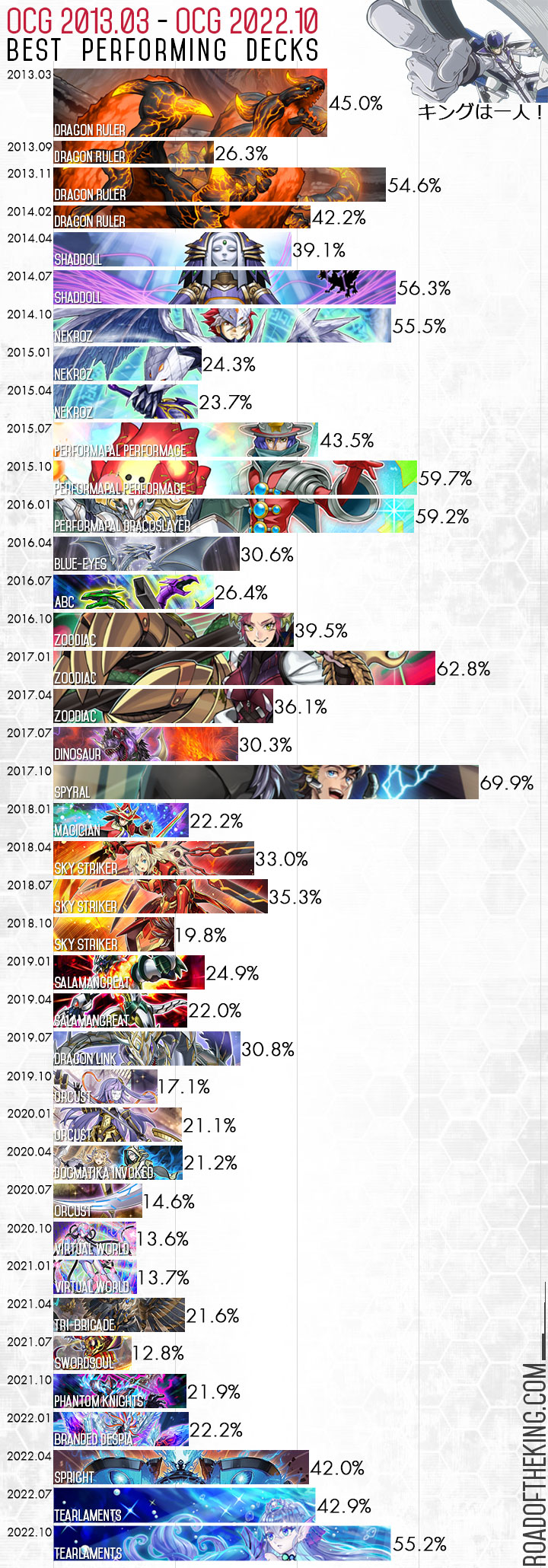
Meta Flow
The upper 60% top decks of each format are shown, up to the top 5 decks.

OCG 2013.03 – OCG 2014.02: Dragon Ruler Dynasty
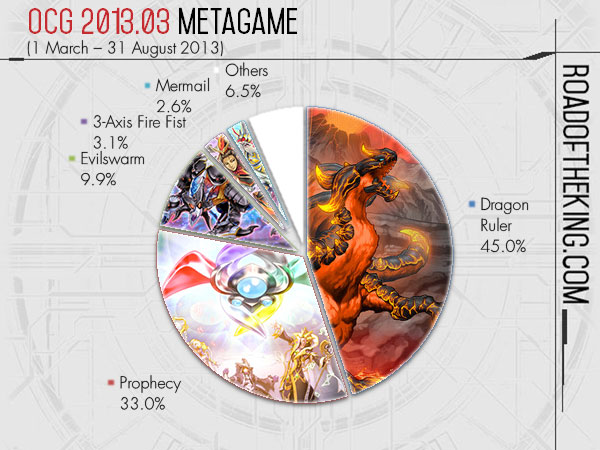
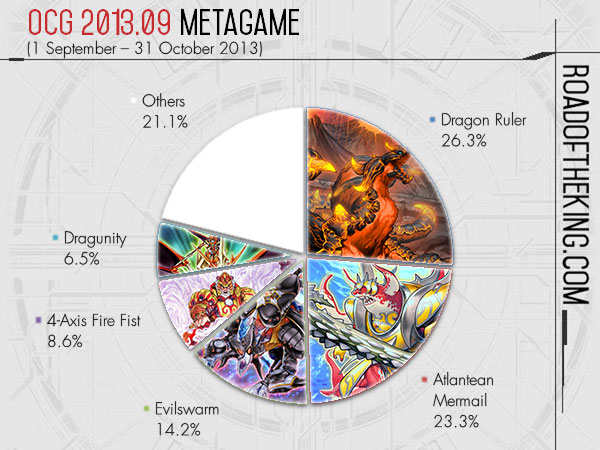
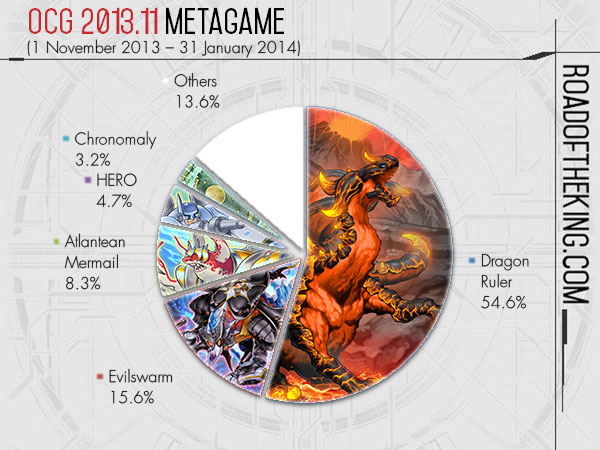
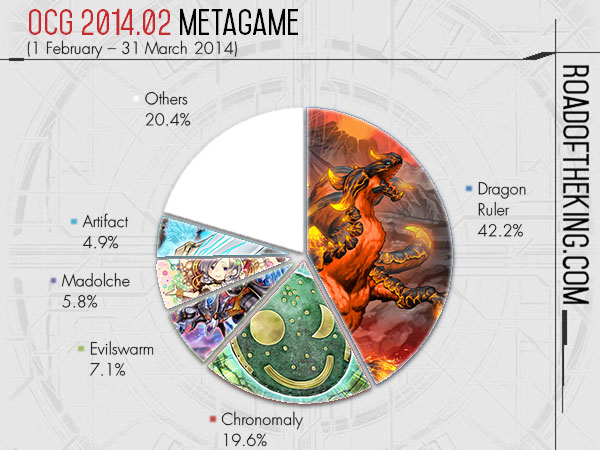
The OCG 2013.03 format was a pivotal moment with the release of Lord of the Tachyon Galaxy, the booster set that changed the design of Yu-Gi-Oh! OCG and ushered in the modern era.
Dragon Ruler could perform multiple Special Summons in a turn, has multiple searching effects, and has effects that activate from the graveyard and banished. Having multiple Special Summons translate to having a faster tempo, meaning the deck could push out more threats in a turn. Having multiple searching effects translate to higher consistency, meaning the deck could assemble their win condition faster. Having effects that activate from the graveyard and banished translate to more card advantage, meaning the deck could generate more resources. All these characteristics would become a common design trend among modern OCG top decks.
This was also the transition period where the Limit Regulation is changed from updating at every 6 months to eventually updating at every 3 months. As such, Dragon Ruler dominated for 4 formats comes up to a total of 13 months, a record that is not beaten in the last decade.
Dragon Ruler would eventually fall out of the first position in OCG 2014.04 after having all the baby Dragon Rulers forbidden, and each of the big Dragon Rulers limited. Amazingly Dragon Ruler still managed to grasp onto the second position despite being heavily weakened.
OCG 2014.04 – OCG 2014.07: Shaddoll, Mother of Fusion
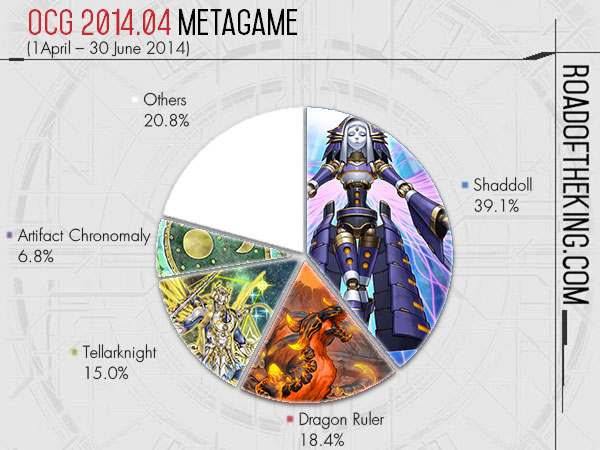
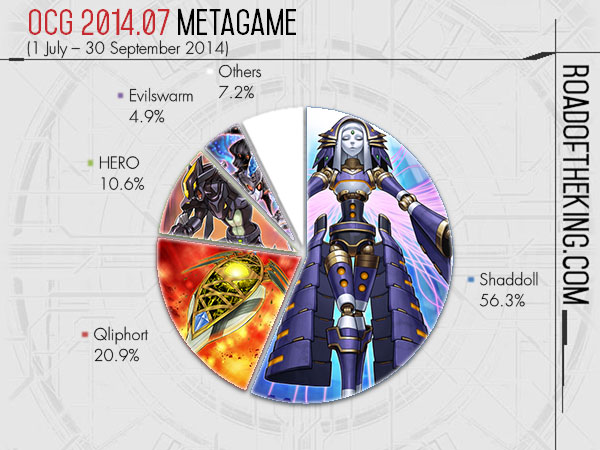
Fusion’s original design was heavily flawed due it being massive card disadvantage. Fusion Summon requires at least two monsters and a Fusion Spell to summon a Fusion Monster, resulting in -2 cards.
Shaddoll Fusion solves this problem by using Fusion Material from deck. Shaddoll monsters would also trigger their effects when sent to the graveyard. El Shaddoll Construct on Special Summon could send a Shaddoll card from deck to the graveyard, and when sent to the graveyard could retrieve a Shaddoll Spell/Trap. All these gains would snowball into card advantage that could quickly overwhelm the opponent. Shaddoll Fusion‘s ability to use Fusion Materials from the deck could also be seen replicated in Red-Eyes Fusion, Fusion Destiny and Branded Fusion.
El Shaddoll Winda is a tenacious threat that restricts Special Summons while being indestructible by effect. El Shaddoll Winda became even more relevant later in the OCG as more decks depends on making multiple Special Summons to setup their play. Dogmatika Invoked and Tearlaments would splash in El Shaddoll Winda.
“Master Rule 3” came into effect in OCG 2014.04, introducing Pendulum Summon, and adding two Pendulum Zones to the playing field. Qliphort was the first Pendulum deck to break into the competitive scene in OCG 2014.07, but Qliphort is closer to a Tribute Summon strategy.
“Master Rule 3” also introduced the ruling whereby the player going first no longer draws during their first turn. For a short period, players would actually prefer to go second. Besides having the extra 6th card when going second, Shaddoll Fusion is also more powerful when the opponent has a monster Special Summoned from the Extra Deck.
OCG 2014.10 – OCG 2015.04: Nekroz, Ritual Successor
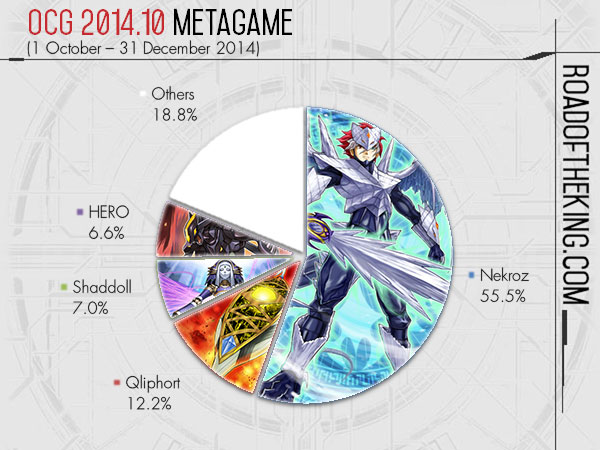
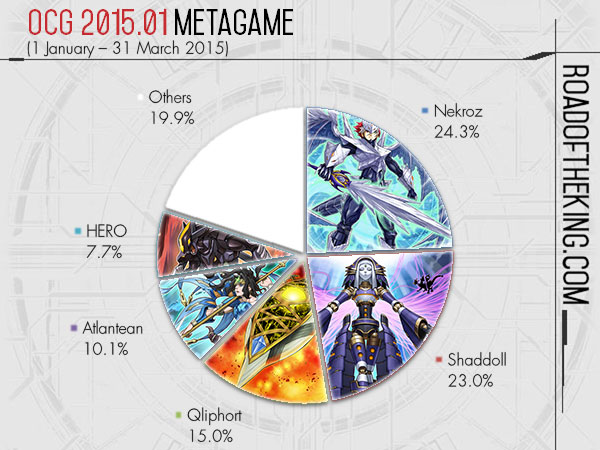
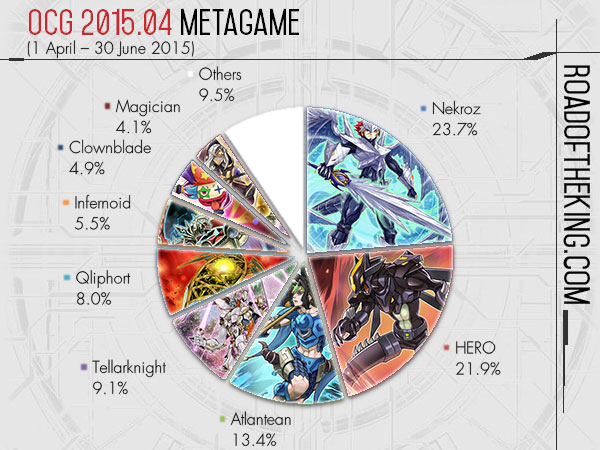
Ritual’s original design was similarly flawed being massive card disadvantage. Ritual Summon requires a Ritual Monster, a Ritual Spell and at least a Tribute material, resulting in a -2.
Nekroz Mirror and Nekroz Kaleidoscope solve this problem by using Ritual Materials from graveyard and Extra Deck. When Herald of the Arc Light is used as Ritual Material and sent from Extra Deck to graveyard, its Trigger Effect could fetch another Ritual Monster or Ritual Spell from deck. Nekroz Cycle solve the problem in another manner by Ritual Summoning the Ritual Monster from the graveyard.
Nekroz had incredible consistency. Besides in-theme Nekroz of Brionac and Nekroz of Clausolas that could search for the Nekroz Ritual Monster and Nekroz Ritual Spell, they also have Manju of the Ten Thousand Hands, Senju of the Thousand Hands and Preparation of Rites at 3 copies each.
Like a reflection of the Duel Terminal story where Nekroz used the powers of the Ice Barrier dragons to seal Shaddoll, in the OCG the debut of Nekroz also resulted in the decline of Shaddoll. Nekroz could play focusing on just their Ritual Monsters and avoid Special Summoning from the Extra Deck, causing Shaddoll Fusion to be unable to use Fusion Material from the deck. Nekroz would also Ritual Summon using Djinn Releaser of Rituals as material, causing Shaddoll to be unable to Fusion Summon altogether.
OCG 2015.07 – OCG 2016.01: Performapal, Duels with Smiles
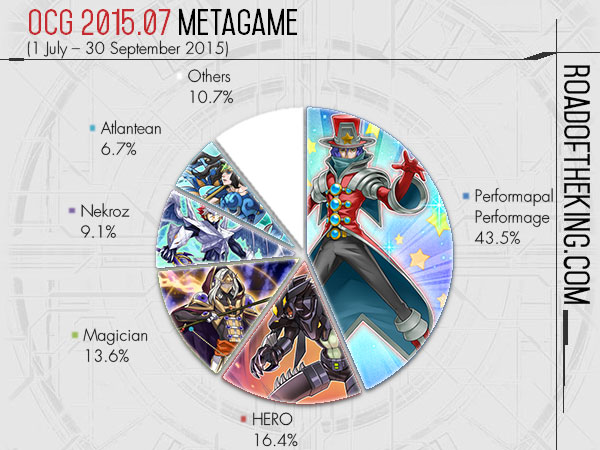
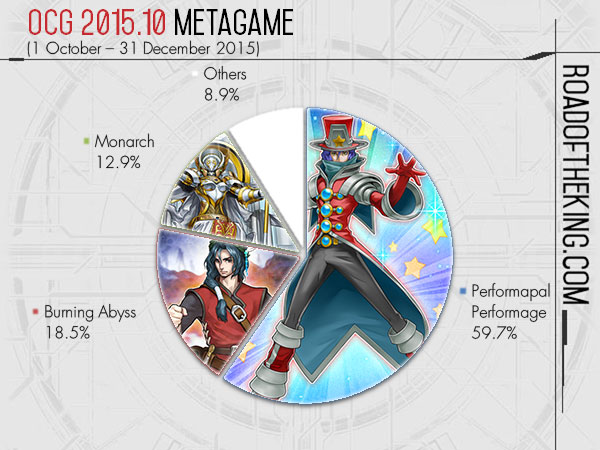
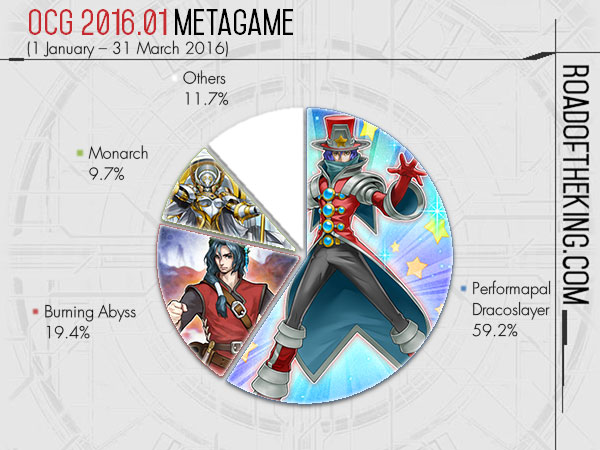
Performapal Performage was the first Pendulum deck to dominate the metagame.
Performapal Pendulum Sorcerer, Luster Pendulum, the Dracoslayer and Wavering Eyes could destroy Performage Plushfire, and then add another card from deck to hand. The destroyed Performage Plushfire would trigger its effect to Special Summon a Performage monster from deck. Performapal Performage could quickly swarm the board with Level 4 monsters to make Rank 4 plays while generating card advantage. Destroying their own Pendulum Monsters also builds up the Extra Deck, allowing them to make a massive Pendulum Summon from the Extra Deck.
Number 16: Shock Master was the most notable Rank 4 Xyz Monster, having an effect that makes the opponent unable to activate Monster Effect, Spell or Trap Card until the end of the opponent’s turn. Tellarknight Ptolemaeus was another noteworthy Rank 4 Xyz Monster, and its effect opens up to Rank 5 plays such as Constellar Pleiades, Stellarknight Constellar Diamond or Cyber Dragon Nova into Cyber Dragon Infinity.
Tellarknight Ptolemaeus was later forbidden in the OCG 2015.10 Limit Regulation, but Extra Pack 2015 was released during mid September 2015. For a very brief 2 weeks, Tellarknight Ptolemaeus effect could be used during the opponent’s turn to Xyz Summon Outer Entity Azathot, making the opponent be unable to activate Monster Effect for the turn.
Performapal Performage has incredible consistency, Performapal Skullcrobat Joker could search for Performapal Pendulum Sorcerer, Performage Damage Juggler could search for Performage Plushfire, and Wavering Eyes could search for any Pendulum Monster. The following booster set Breakers of Shadow improved the consistency further, giving Performapal Monkeyboard to search for Performapal Skullcrobat Joker or Performapal Pendulum Sorcerer, and Draco Face-Off to search for Luster Pendulum, the Dracoslayer.
Performage Plushfire was forbidden in the OCG 2016.01 Limit Regulation, becoming the fastest card in OCG history to become forbidden after 167 days since its release. Performapal Performage adapted into Performapal Dracoslayer and continue to dominate the OCG 2016.01 format. Even without Number 16: Shock Master or Tellarknight Ptolemaeus to directly shutdown the opponent’s play, Performapal Dracoslayer consistency and card advantage is still way above the rest of the decks in the metagame.
Performapal Monkeyboard was forbidden in the OCG 2016.04 Limit Regulation, tying with Performage Plushfire to become the fastest card in OCG history to become forbidden after 167 days since its release.
OCG 2016.04 – OCG 2016.07: Blue-Eyes and ABC, Kaiba’s Outbreak
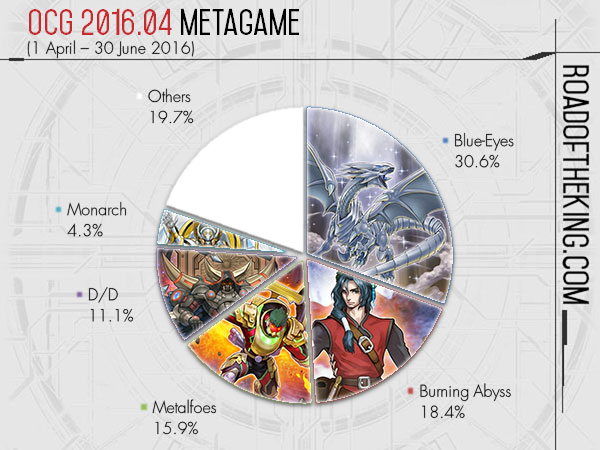
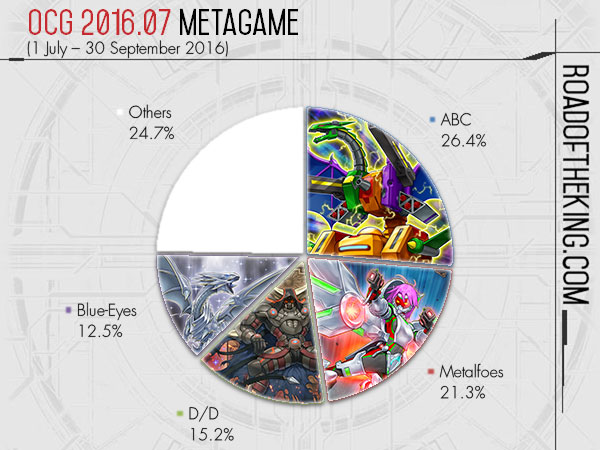
Blue-Eyes and Burning Abyss were released months ago but were overshadowed by Performapal Performage and Performapal Dracoslayer. With these two decks heavily hit by the Limit Regulation, Blue-Eyes and Burning Abyss finally have a chance to compete in the metagame.
Blue-Eyes has an edge over the OCG 2016.04 metagame with Blue-Eyes Spirit Dragon. Blue-Eyes Spirit Dragon Quick Effect could negates graveyard effect and is useful against Phantom Knights Burning Abyss. Blue-Eyes Spirit Dragon Continuous Effect prevents 2 or more monsters from being Special Summoned at the same time and is effective in stopping Metalfoes from Pendulum Summoning multiple monsters.
In the next OCG 2016.07 format, ABC would swiftly displace Blue-Eyes. ABC has a superior boss monster in ABC-Dragon Buster, and the ability to make Rank 4 plays. Rank 4 are the premium Xyz Monsters at this point in the OCG, having Castel, the Skyblaster Musketeer, Diamond Dire Wolf, Evilswarm Exciton Knight for removal effects, Abyss Dweller to seal graveyard effects, and Number 39: Utopia into Number S39: Utopia the Lightning to attack over high ATK monster.
OCG 2016.10 – OCG 2017.04: Zoodiac, Fruits Basket
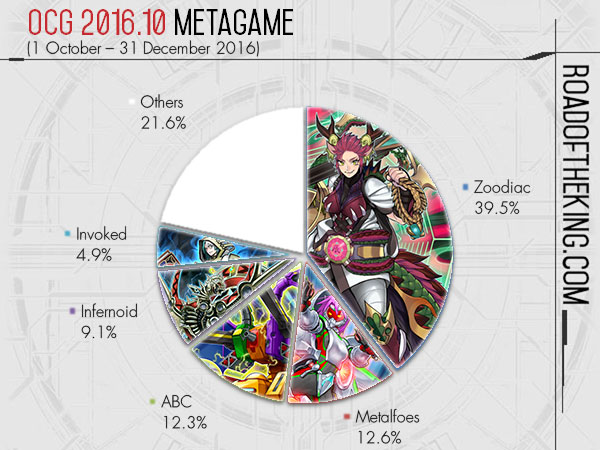
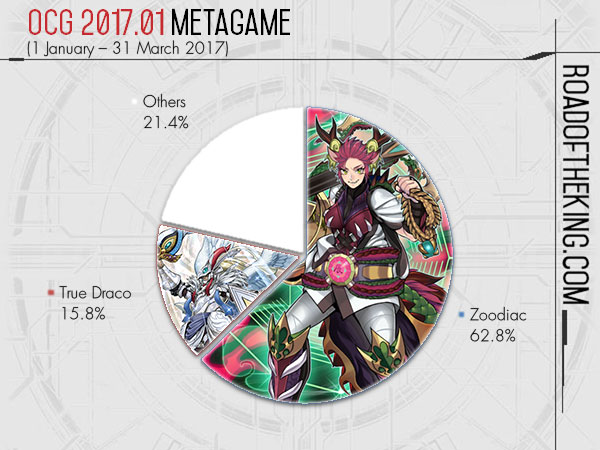
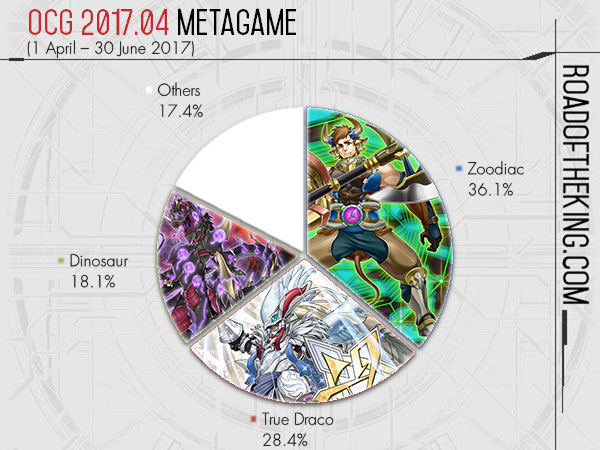
Zoodiac debut in Raging Tempest and took the metagame by storm. Zoodiac has a 1-card combo that opens with just 1 Zoodiac Ratpier, and finishes with 2 Zoodiac Ratpier which could be used to make a Rank 4 Xyz Monster such as Daigusto Emeral that could draw 1 card, a Zoodiac Broadbull to add a Beast-Warrior monster to hand, and a Zoodiac Drident that could destroy 1 face-up card.
This is the basis of the 1 starter + 4 disruption concept, making Zoodiac the pioneer of the Midrange deck design. The 1 starter + 4 disruption concept is having a consistent standard combo that the deck could pull off with just 1 or 2 cards which converts into 1 or 2 more disruptions on the field. With the other 4 disruptions in the form of ‘hand traps’ or Spell/Trap Cards drawn in your opening hand, you would have a total of 6 disruptions. Just by using these 6 disruptions to trade 1-for-1 with the opponent’s opening 6 cards would essentially stop all their plays. Of course this is merely theoretical and Zoodiac often would not open with the perfect 1 starter + 4 disruption. But at this point in the OCG, Zoodiac is the only deck with a 1-card starter, whereas other decks like Metalfoes or ABC requires 2 – 3 cards to start, which means Zoodiac effectively only needs 3 or 4 disruptions to shutdown their opponent’s play.
Zoodiac also has incredible impeccable consistency. Besides having 3 Zoodiac Ratpier, the deck also has 3 Zoodiac Barrage, 3 Fire Formation – Tenki and 3 Speedroid Terrortop to make M-X-Saber Invoker to search for Zoodiac Ratpier.
All these together makes Zoodiac an exceptional deck above the rest in the format, like an onigiri in a fruits basket. In the OCG 2017.01 format, 62.8% of the top decks are Zoodiac, while another 31.5% of the top decks are running the Zoodiac package for the Ratpier combo, giving Zoodiac an astonishing total of 94.3%.
“New Master Rule” came into effect in OCG 2017.04, introducing Link Summon and adding two Extra Monster Zone to the playing field, while the two Pendulum Zones were relocated to the Spell/Trap Zone. Monsters Special Summoned from the Extra Deck could only be placed in the Extra Monster Zone or in a Main Monster Zone pointed to by a Link Arrow. True Draco was unaffected by the changes and Zoodiac was minimally impacted.
The OCG 2017.04 Limit Regulation had Zoodiac Drident forbidden, and Zoodiac switched up to running Master Peace, the True Dracoslaying King as their new boss monster. A Master Peace, the True Dracoslaying King Tribute Summoned using a Monster and Trap would give it immunity to Monster Effect and Trap, and is effective in the True Draco Zoodiac mirror match and Demise True Draco matchup. Gameciel, the Sea Turtle Kaiju were ran in the Side Deck as an out to Master Peace, the True Dracoslaying King.
OCG 2017.07: True King vs True Draco
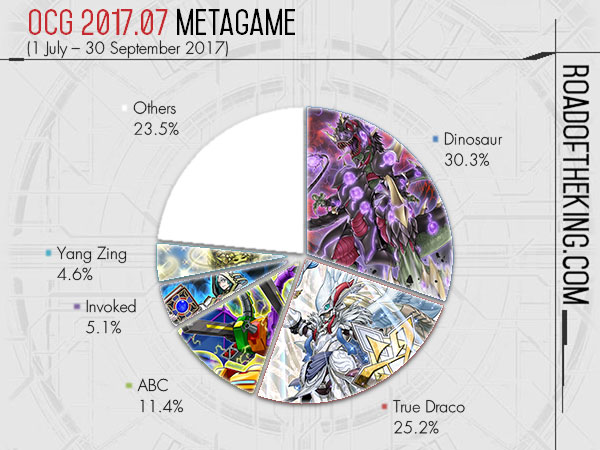
The OCG 2017.07 Limit Regulation added Zoodiac Broadbull to forbidden, ending the reign of Zoodiac and opening up for True King Dinosaur and True Draco to take over the metagame.
True King Yang Zing Dinosaur could open with a Souleating Oviraptor in end with Denglong, First of the Yang Zing and Nine Pillars of Yang Zing, which would follow into Herald of the Arc Light, for a total of 2 negations. With Dragonic Diagram, they could then open with True King of All Calamities to shutdown the opponent’s Monster Effects for the whole turn.
True King Lithosagym, the Disaster effect could also snipe off powerful monsters from the Extra Deck, such as ABC-Dragon Buster and Invoked Mechaba, greatly reducing the threat that ABC and Invoked could put out. Demise True Draco would also run a fake Extra Deck to throw off their opponent when they look at the Extra Deck with True King Lithosagym, the Disaster effect during the first game, though would only be effective for the first few rounds of the tournament.
True King Dinosaur and True Draco’s top cut metagame share might seem fairly even, but True King Dinosaur’s usage was bounded by the availability of Jurrac Aeolo. True King Dinosaur requires 2 copies of Jurrac Aeolo, a Duel Terminal card which has not been reprinted since Duel Terminal – Charge of the Genex!! and Duel Terminal Chronicle 3 – Chapter of Destruction, resulting in a severe shortage available in circulation. Many cliques had to pool together their Jurrac Aeolo such that only two or three of them could build the True King Dinosaur deck. Meanwhile the True Draco deck is largely made up of common cards and could be easily acquired from the recent Maximum Crisis booster set, making True Draco a much more popular pick.
OCG 2017.10: SPYRAL×FAMILY
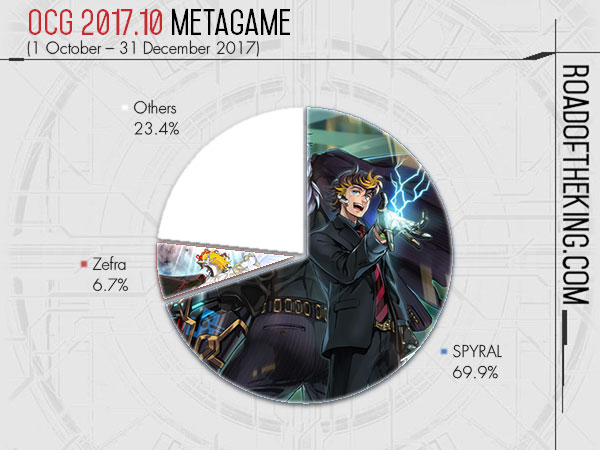
In the final weeks of OCG 2017.07 format, SPYRAL shortly after its debut had overtaken True King Dinosaur to be the top. The new OCG 2017.10 Limit Regulation weakened both True King Dinosaur and True Draco, leaving SPYRAL to become the sole top contender of the new format.
SPYRAL is the first Combo deck based on Link Monsters that dominated the metagame. By recursively Special Summoning SPYRAL Quik-Fix from the graveyard, SPYRAL could quickly Special Summon a board of Link Monsters. A standard end board would consist of Tri-Gate Wizard, Firewall Dragon, SPYRAL GEAR – Utility Wire and SPYRAL Sleeper equipped with SPYRAL GEAR – Last Resort. SPYRAL GEAR – Drone would also rearrange the top 3 cards of the opponent’s deck making it unlikely for the opponent to draw a board clear.
SPYRAL also marked the beginning of long extended combos that ends with multiple disruptions. A year ago, D/D was a top contender Combo deck, using 3 or 4 cards to start their combo which goes up to 16 steps. Now SPYRAL just needs 2 cards to start their combo which takes up to 44 steps to setup their end board.
SPYRAL would go down in history with a quarterly high of 69.9% dominance over the format, before being swiftly taken out by the next OCG 2018.01 Limit Regulation.
OCG 2018.01: Link into the VRAINS
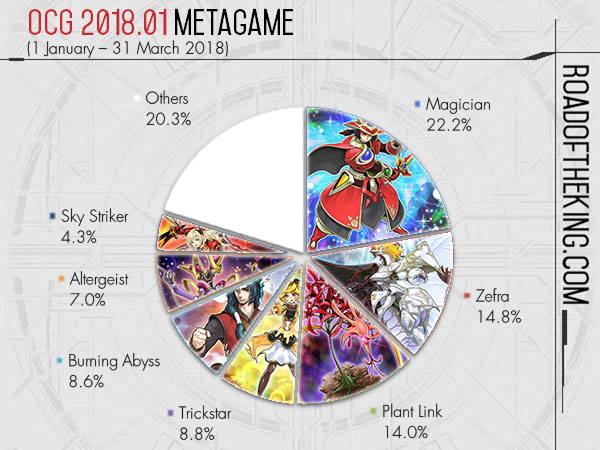
LINK VRAINS Pack has a huge impact on the OCG 2018.01 metagame. Magician and Zefra were using Heavymetalfoes Electrumite, Plant Link was using Aromaseraphy Jasmine and Curious, the Lightsworn Dominion, Burning Abyss and Plant Link were using Cherubini, Ebon Angel of the Burning Abyss, and almost every deck was using Crystron Halqifibrax.
LINK VRAINS Pack introduced many of these new Link Monsters with downwards left and downwards right Link Arrows to help various old themes adapt to the “New Master Rule” by making it easier for them to open up their Main Monster Zones. Hieratic Seal of the Heavenly Spheres and Isolde, Two Tales of the Noble Knights would also see plays in later formats.
Heavymetalfoes Electrumite was pivotal in propelling Magician to the top. Double Iris Magician could not activate its Pendulum Effect on the first turn, but Heavymetalfoes Electrumite provided a way to destroy Double Iris Magician so its Monster Effect could fetch a “Pendulumgraph” card. More importantly Heavymetalfoes Electrumite could add Astrograph Sorcerer from deck to the Extra Deck, and then destroy a Pendulum Scale to add Astrograph Sorcerer from Extra Deck to hand. Chain 2 Astrograph Sorcerer would be able to Special Summon itself from hand and add a Monster that was destroyed this turn from deck to hand, Chain 1 Heavymetalfoes Electrumite effect would draw a card. The Heavymetalfoes Electrumite and Astrograph Sorcerer interaction generates a significant card advantage while setting up the board, and would become a fundamental combo in many Pendulum decks.
Flames of Destruction was also released early in January 2018, introducing Called by the Grave a powerful counter against ‘hand traps’, and Infinite Impermanence a more flexible Effect Veiler. This was also the debut of the Knightmare Link monsters which would become staples in many decks for their ease of summoning and versatile utility effects.
OCG 2018.04 – OCG 2018.10: Sky Striker, X-003 Sortie
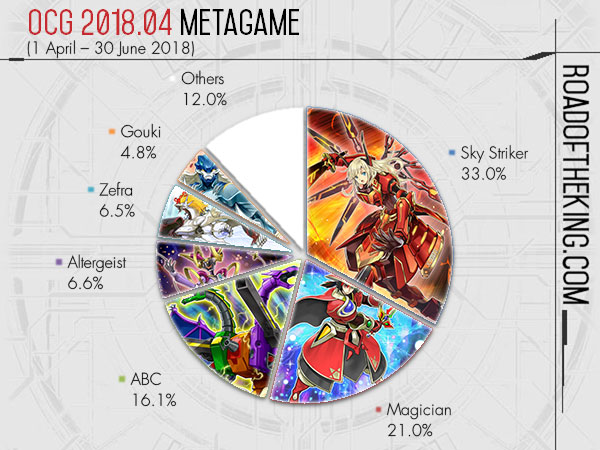
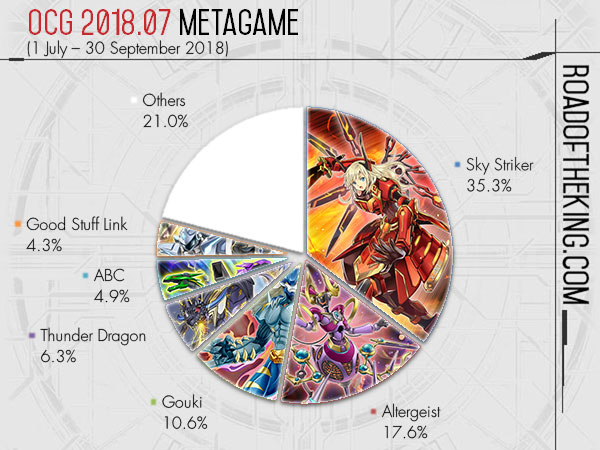
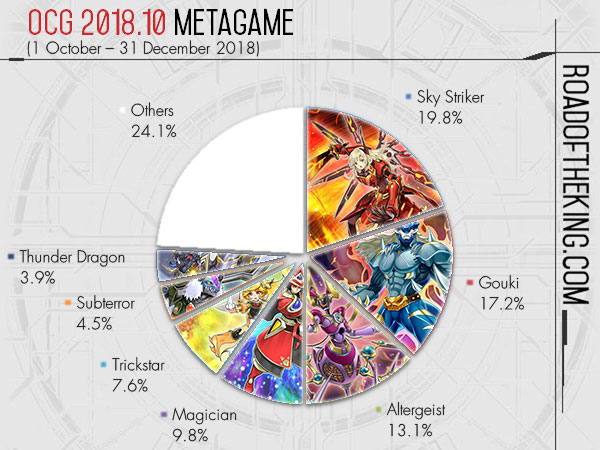
The release of Sky Striker Ace – Hayate in Cybernetic Horizon launched Sky Striker to the top of the metagame. While Sky Striker was already doing decently on debut, but more decks were just using running Sky Striker as a small package to make a 1-card Link-2 monster using Sky Striker Mecha – Hornet Drones without taking up the Normal Summon.
Sky Striker Ace – Hayate massively increased Sky Striker’s consistency, providing a way to send Sky Striker Mobilize – Engage! from deck to graveyard so it could be retrieved by Sky Striker Ace – Kagari, or send Sky Striker Ace – Raye from deck to graveyard so it could be Special Summoned when a Sky Striker Link Monster leaves the field by battle or opponent’s card effect. Sending any other Sky Striker Spell to the graveyard is also useful to build up the Spell count in the graveyard, enabling Sky Striker Mobilize – Engage! to draw a card.
Sky Striker Spells are not limited to once per turn, and they could occasionally have Sky Striker Mobilize – Engage! draw into another Sky Striker Mobilize – Engage!, pulling off a huge card advantage lead right off the start. Once Sky Striker starts snowballing their card advantage, many decks will be unable to catch up.
However as a Control deck, Sky Striker has a slow win condition, having to slowly grind out the opponent’s resources, resulting in Sky Striker frequently going into overtime during tournaments. Sky Striker could win in the Extra Turns by dealing direct damage with Sky Striker Ace – Hayate, then use Sky Striker Mecha – Eagle Booster and Sky Striker Mecha – Widow Anchor to disrupt the opponent’s counterattack.
The limitation of Sky Striker Ace – Kagari would eventually caused Sky Striker to fall from the top spot, but Sky Striker would remain in the competitive scene for many formats that follows, becoming a regular among the OCG metagame pie charts.
OCG 2019.01 – OCG 2019.04: Salamangreat, Reincarnating Flame
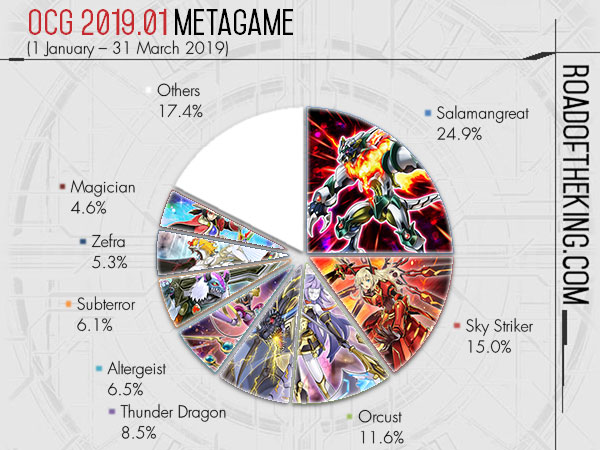
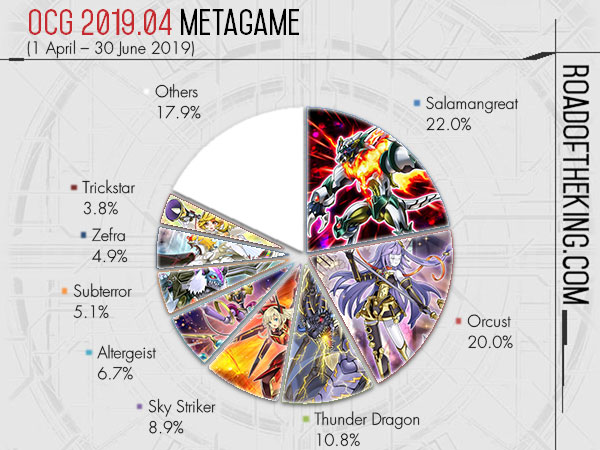
Salamangreat debuted in Soul Fusion and had another wave of support in Savage Strike, but burst into the competitive scene with the release of Structure Deck: Soulburner.
Structure Deck: Soulburner essentially reworked the whole Salamangreat theme, making it a cohesive strategy to turbo out Salamangreat Sunlight Wolf and generate card advantage from it. Salamangreat Sunlight Wolf could salvage a FIRE monster from the graveyard, besides retrieving Salamangreat Gazelle for their next turn, they could also loop back Ash Blossom & Joyous Spring to disrupt the opponent. Then after being Reincarnation Link Summoned, Salamangreat Sunlight Wolf could retrieve a Salamangreat Spell/Trap from the graveyard, namely Salamangreat Rage or Salamangreat Roar to disrupt the opponent.
Salamangreat is a Midrange deck that requires just 2-cards to make their plays, and could run a high amount of ‘hand traps’ to disrupt the opponent, allowing them to compete against prime Orcust with Knightmare Mermaid combo.
OCG 2019.07: Dragon Link, Duel in the Extreme Domain
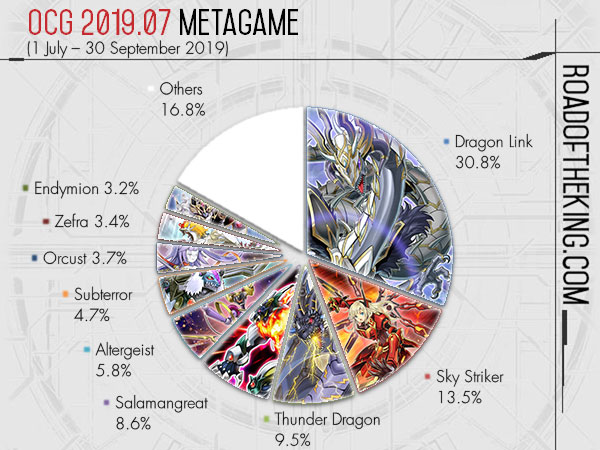
The Guardragon Link Monsters have already proven themselves to be a powerful engine for the Dragon deck, previously enabling the Gandora-X the Dragon of Demolition FTK deck. As the OCG 2019.07 Limit Regulation had Gandora-X the Dragon of Demolition forbidden, Dragon Link switched over to Topologic Gumblar Dragon instead to discard the opponent’s hand.
The release of Structure Deck: Revolver and the V Jump promotional card Striker Dragon was a significant boost to Dragon Link, allowing the deck to run Quick Launch to Special Summon a Rokket monster from the deck. However, it was Starliege Seyfert released later in Chaos Impact that propelled Dragon Link right to the top. Starliege Seyfert could search for Black Dragon Collapserpent, which in turn would fetch White Dragon Wyverburster, providing bodies for Dragon Link to use for Synchro Summon or Link Summon. Dragon Link also has 3 Called by the Grave and 3 Crossout Designator to negate the opponent’s ‘hand traps’, and a variety of extenders, making it extremely difficult to stop Dragon Link from popping off with their combo.
The standard Dragon Link end board consists of Borreload Savage Dragon, Topologic Gumblar Dragon and Hieratic Seal of the Heavenly Spheres. During their own turn, Topologic Gumblar Dragon effect would discard 2 cards from opponent’s hand. Then during the opponent’s Draw Phase, Hieratic Seal of the Heavenly Spheres effect would be activate by tributing itself to bounce 1 card to hand, and then Special Summon Koa’ki Meiru Drago from deck to a zone a Link Monster points to. Topologic Gumblar Dragon Trigger Effect would activate to discard another 2 cards from opponent’s hand. The opponent is now left with just 2 cards in hand going up against Borreload Savage Dragon which could negate a card activation and Koa’ki Meiru Drago which stops both players from Special Summoning LIGHT or DARK monsters.
OCG 2019.10 – OCG 2020.07: Orcust, Galatea Cantabile
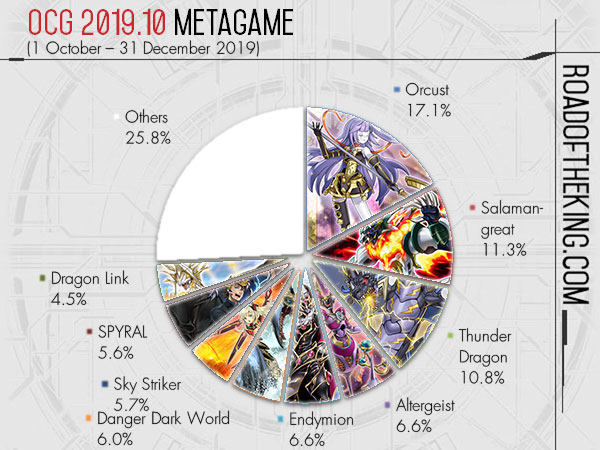
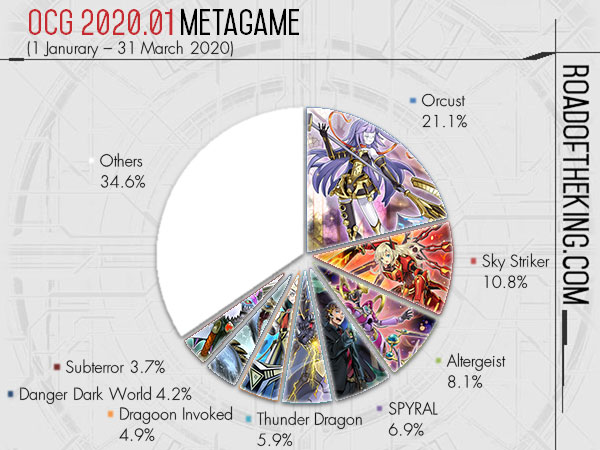
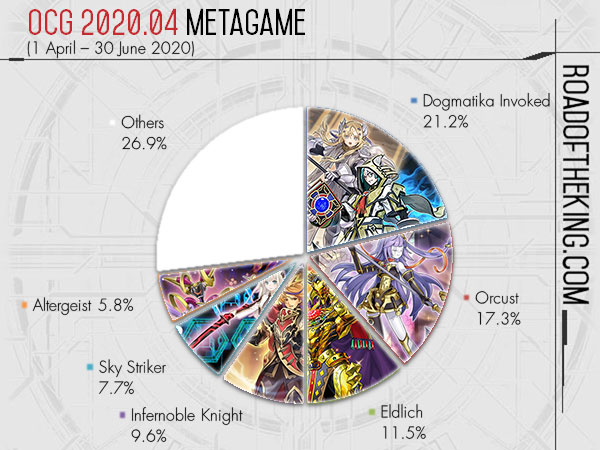
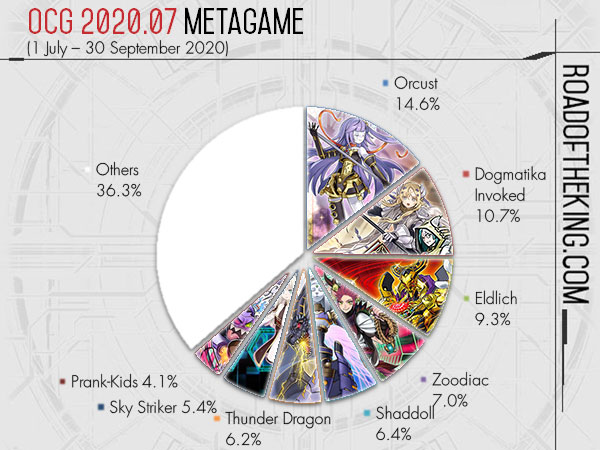
Orcust fell off momentarily after losing Knightmare Mermaid, but bounced back right after the Dragon Link format. A significant change to Orcust is the dropping of the Phantom Knights package, and instead focus using Orcustrated Babel to activate Orcust Monster Effects during the opponent’s turn. Orcust Cymbal Skeleton could Special Summon Dingirsu, the Orcust of the Evening Star from the graveyard which in turn could send an opponent’s card to the graveyard. I:P Masquerena is also used to Link Summon during the opponent’s turn, bringing out Knightmare Unicorn or Topologic Link Monsters to disrupt the opponent.
Towards the end of OCG 2019.10 format, the release of Predaplant Verte Anaconda followed by Red-Eyes Dark Dragoon saw many decks incorporating them, including Orcust. Red-Eyes Dark Dragoon cannot be targeted and destroyed by card effects, making it extremely difficult to deal with at this point in the metagame, and comes with the effect to negate the activation of a card or effect. Red-Eyes Dark Dragoon could win games by itself, and was worth the risk of drawing Dark Magician and Red-Eyes Black Dragon.
The release of Girsu, the Orcust Mekk-Knight in Eternity Code gave Orcust an in-theme starter and was a major consistency boost, allowing Orcust to continue its lead in the OCG 2020.01 format. Eternity Code also came with Accesscode Talker, which quickly replaced Borrelsword Dragon as the easier Link-4 Monster to bring out as a finisher.
“New Master Rule (April 2020 Revision)” was implemented in the OCG 2020.04 format, and it allowed Fusion, Synchro and Xyz Monsters to be Special Summoned from the Extra Deck to any Main Monster Zone directly without requiring Link Arrows. Rise of the Duelist was also released in April 2020 and brought along several answers to Red-Eyes Dark Dragoon such as Forbidden Droplet, Triple Tactics Talent and Dogmatika Fleurdelis, the Knighted.
Dogmatika Invoked had a brief element of surprise, allowing them to run Dogmatika Maximus without repercussions. But the metagame adapted as players started running Elder Entity N’tss and Cyber Dragon Nova for Invoked Mechaba in the Extra Deck as a countermeasure against Dogmatika Maximus.
Dogmatika Invoked had difficulties keeping up without Dogmatika Maximus to generate card advantage, and Orcust regained its position as the top deck in the following OCG 2020.07 format.
OCG 2020.10 – OCG 2022.01: Variety is the Spice of Life
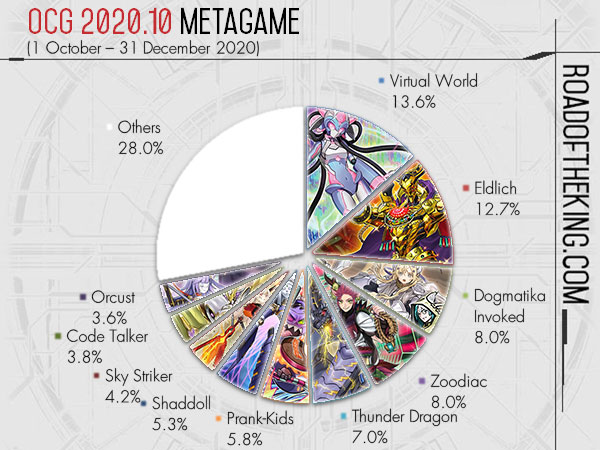
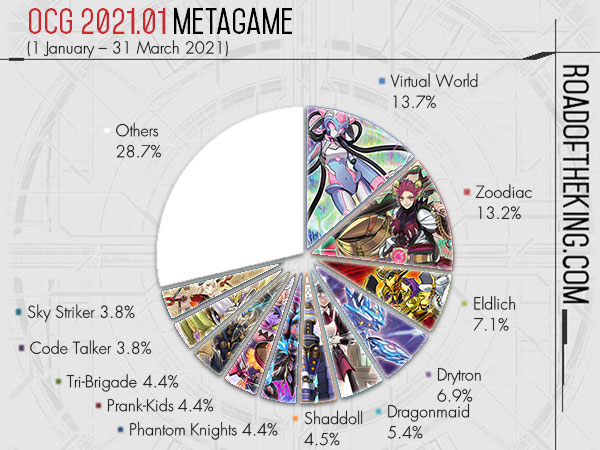
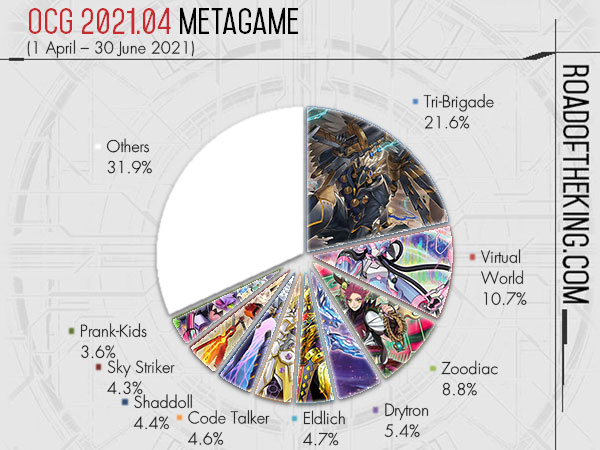
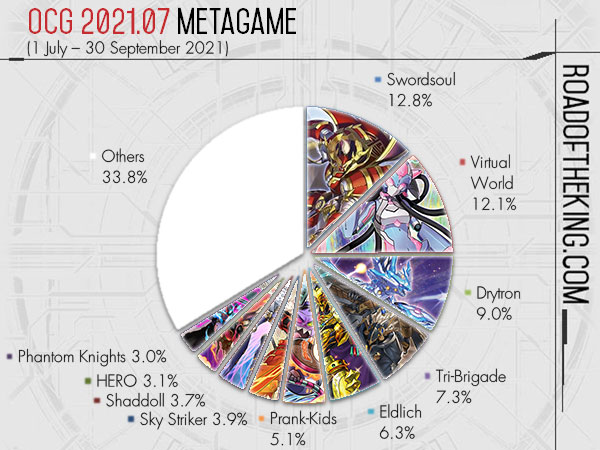
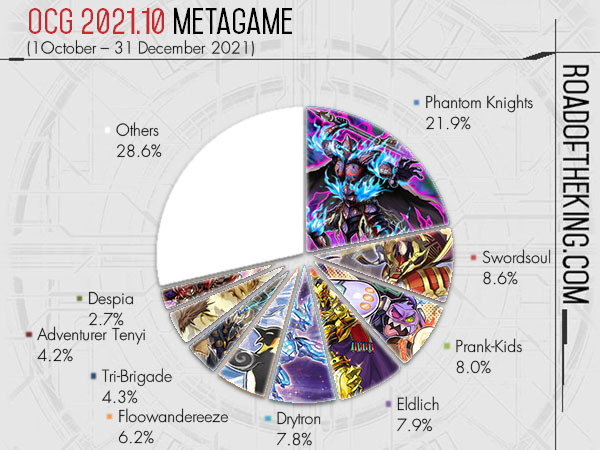
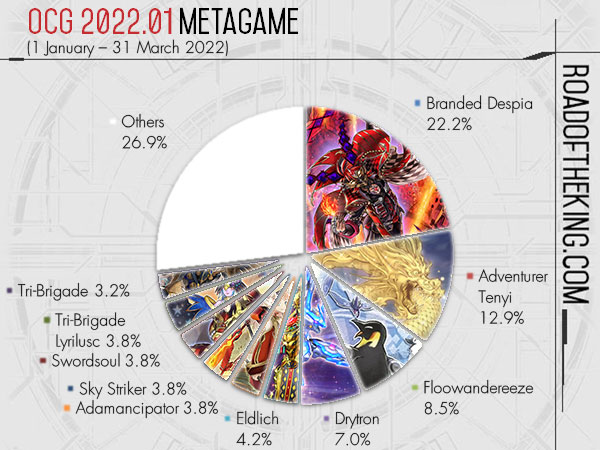
The OCG 2020.10 to OCG 2022.01 formats were the most diverse across the whole decade. Many of the top decks of each format were just marginally better than the rest of the format. The top 5 decks of each format barely adds up to 50%, and decks that follows behind takes an even smaller share. Almost everyone could have a share of the pie.
Virtual World is a Combo deck that locks down using True King of All Calamities, but suffers from consistency issues. Tri-Brigade, Swordsoul, Destiny Adventurer Phantom Knights and Branded Despia are Midrange decks that are just marginally stronger than the previous top contender, largely thriving on a balance of consistency and power.
There is also a lot more generic power cards in these format that could be played in many different decks. Accesscode Talker, Divine Arsenal AA-ZEUS – Sky Thunder, Destiny HERO – Destroyer Phoenix Enforcer and Adventurer package provided common access to powerful effects, and thus reduced the power imbalance between decks.
OCG 2022.04 – OCG 2022.10: Spright and Tearlaments, Crying Lightning
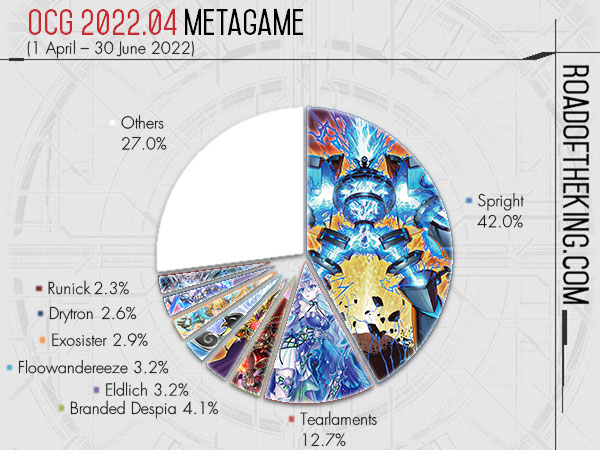
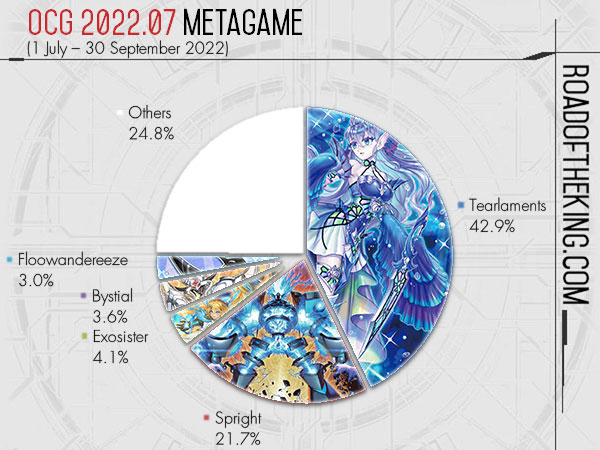
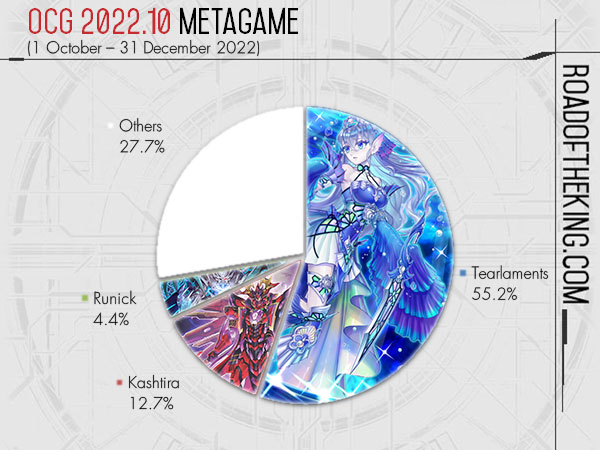
Power of the Elements would go down in OCG history as one of the most impactful booster set ever released, perhaps comparable with Lord of the Tachyon Galaxy.
Spright on debut took over the OCG 2022.04 format by storm. Spright monsters could be Special Summoned from hand as long as there is a respective Level 2, Rank 2 or Link-2 monster on the field. This essentially makes every Spright monster an extender, allowing Spright to quickly swarm the field and setup their board. Spright has the most utility Extra Deck Monsters, Gigantic Spright to Special Summon a Level 2 monster from deck, Spright Elf to Special Summon a Level 2/Rank 2/Link-2 monster from graveyard, and Spright Sprind to send a Level 2 monster from deck to graveyard. However, they lack a threatening end board and have to rely on outside their theme such as Toadally Awesome and Union Carrier to equip Dragon Buster Destruction Sword.
Towards the end of the OCG 2022.04 format, Tearlaments would overtake Spright with the release of the Ishizu monsters in Duelist Pack: Duelists of Pyroxene. Kelbek the Ancient Vanguard and Agido the Ancient Sentinel provided a way to send cards from top of deck to graveyard, and thus triggering Tearlaments graveyard effects to Fusion Summon. Keldo the Sacred Protector and Mudora the Sword Oracle that were sent to the graveyard could also provide graveyard disruption.
Tearlaments is a vast improvement on the Fusion design, cutting out the requirement of a Fusion Spell altogether. Tearlaments would Fusion Summon using their monster effects when they are sent to the graveyard by effect, and could use materials from hand, field and/or graveyard. Besides being immune to Retaliating “C”, this also generate card advantage as it is possible to use all Fusion Materials from the graveyard. Tearlaments could also run a minimal amount of Fusion Monsters as they could be recycled when used as materials, opening up space in the Extra Deck for more utility options.
Tearlaments would continue to get stronger after Darkwing Blast and Photon Hypernova, gaining Tearlaments Rulkallos, Tearlaments Scream and Tearlaments Kashtira, and would dominate consecutively in the OCG 2022.07 and OCG 2022.10 formats.
The OCG 2023.01 Limit Regulation would deal a heavy blow to Tearlaments, making Tearlaments Kitkallos forbidden and Tearlaments Reinoheart, Tearlaments Scheiren, Pressured Planet Wraitsoth limited. The previous OCG 2022.10 Limit Regulation already had Primeval Planet Perlereino, Keldo the Sacred Protector, Agido the Ancient Sentinel limited and Tearlaments Havnis semi-limited. Despite all these hits, Tearlaments remains a top contender in the competitive scene.
Conclusion
The above is just a brief overview of the OCG metagame over the past decade. As the focus is largely on the best deck of each format based on their total accumulated tops, there are bound to be nuance details missed out along the way. Be that as it may, it is rather interesting to observe how the game design and power level has grown incrementally over the past decade.
May Yu-Gi-Oh! OCG continue to bring forth new and exciting formats for another decade to come.

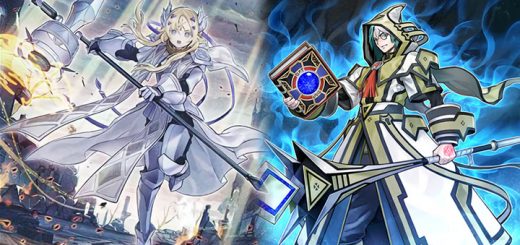
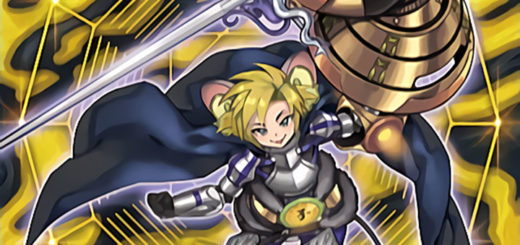
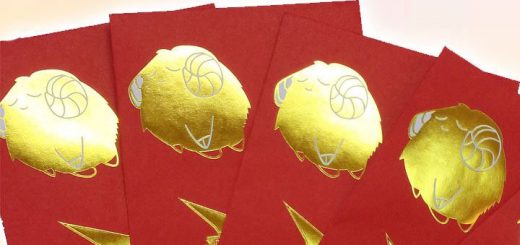
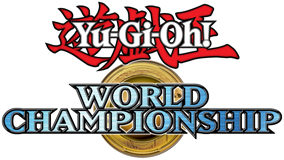


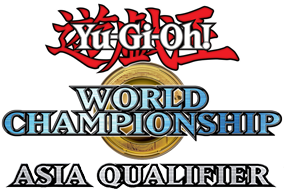
Thank you for your effort and hard work compiling all this data!
Crazy how bad Red-Eyes Fusion was despite being released a year after Shaddoll Fusion.
Thanks a lot for recording all of the information on competitive OCG tournaments over the past decade. I think this is the first blog to clearly and accurately convey information on the OCG metagame in English that doesn’t have a jerk as an owner. Sites like this are a valuable tool for future Yu-Gi-Oh fans that want to learn about the game’s history.
Also, I loved this part:
“A year ago, D/D was a top contender Combo deck, using 3 or 4 cards to start their combo which goes up to 16 steps. Now SPYRAL just needs 2 cards to start their combo which takes up to 44 steps to setup their end board.”
Thanks for this work.
damn i didnt know blue-eyes was meta at one point
It’s funny cause players kept bricking in tournaments playing it
Brilliant article. It made its points concisely and backed them up with sound and well-presented data. It was really neat to see the two graphs topping the article because their attractive design kept my attention on them. I certainly found myself remembering a lot of knowledge I had forgotten.
Thank you for being the best writer featuring our OCG brothers! Lets hope this decade is even better
AMAZING WORK DUDE!
Was shadoll a tier 0 in OCG?
no
You are a treasure to the Yu-Gi-Oh community, I hope to read your content for years to come! I Hope.
Great job!
Wow, this is an extremely cool and comprehensive article! Best I’ve ever read
ADA was never meta in OCG,how?
May I ask whether the name of ROTK website originate from Jack Atlas Video of 5D’s Animation, or not?